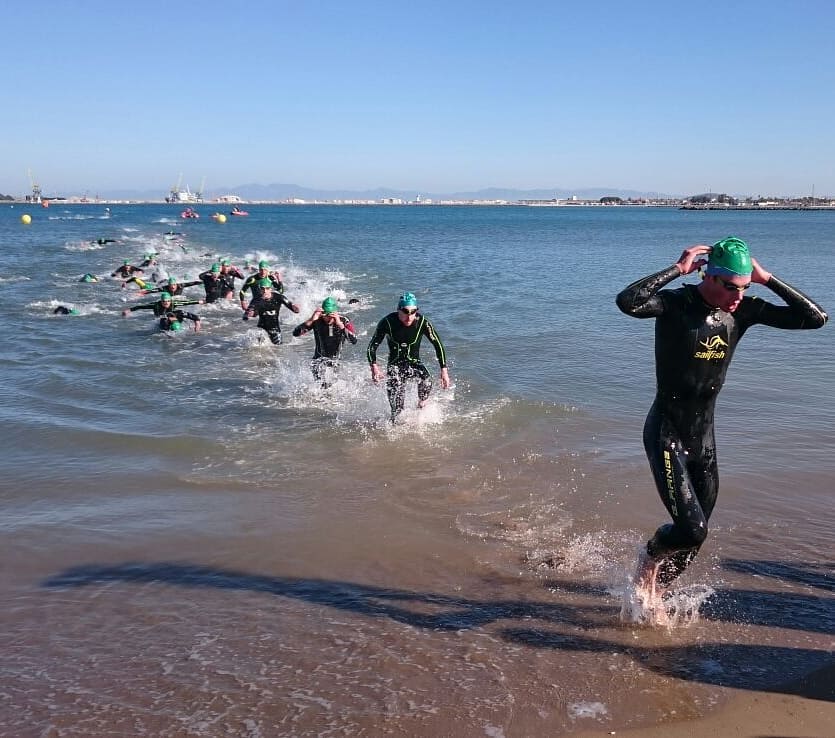Melilla delights: van der Stel steals victory and Alonso’s run delivers gold
Melilla welcomed athletes from all over Europe for the ETU Junior European Cup and the ETU European Cup. The sun came out and warmed up the water but not quite enough for a non-wetsuit swim and with the people of Melilla knowing much more about triathlon, the crowds knew that they would get a great show.

Early morning saw the Junior athletes race and, with the long days available to the organisers, it was the Elite in the afternoon and evening.
The Elite Women lined up on the beach in the afternoon sunshine. Race favourite was Italy’s Verena Steinhauser. With her knowledge of the course and a bronze medal from 2017 she would be the one to watch. The home crowds would be cheering on Ines Santiago ESP and Spain’s reigning national champion, Sara Pérez Sala. Together with Cecilia Santamaria Surroca the host nation was fielding a strong team. Netherland’s Kirsten Nuyes, who has been racing strong recently, woke that morning feeling dreadful but took a gamble on starting.
The athletes were introduced, one by one and made their way onto the beach. The water is quite shallow for quite some way and athletes had been practicing their starts over the days before the race to make sure they could get maximum advantage over the initial minutes.
A massive breakaway was soon established by Sara Pérez Sala. The only athlete to be able to keep any pace with her was Portugal’s Helena Carvalho. Long and strong strokes, with so much pull through the water gave Pérez the advantage.
She swam effortlessly around the two lap course and she exited the sea with one of the biggest leads we have seen for a while. Just a few steps behind her was Carvalho and the question on everyone’s lips was “can they ride like Learmonth and Coldwell?”
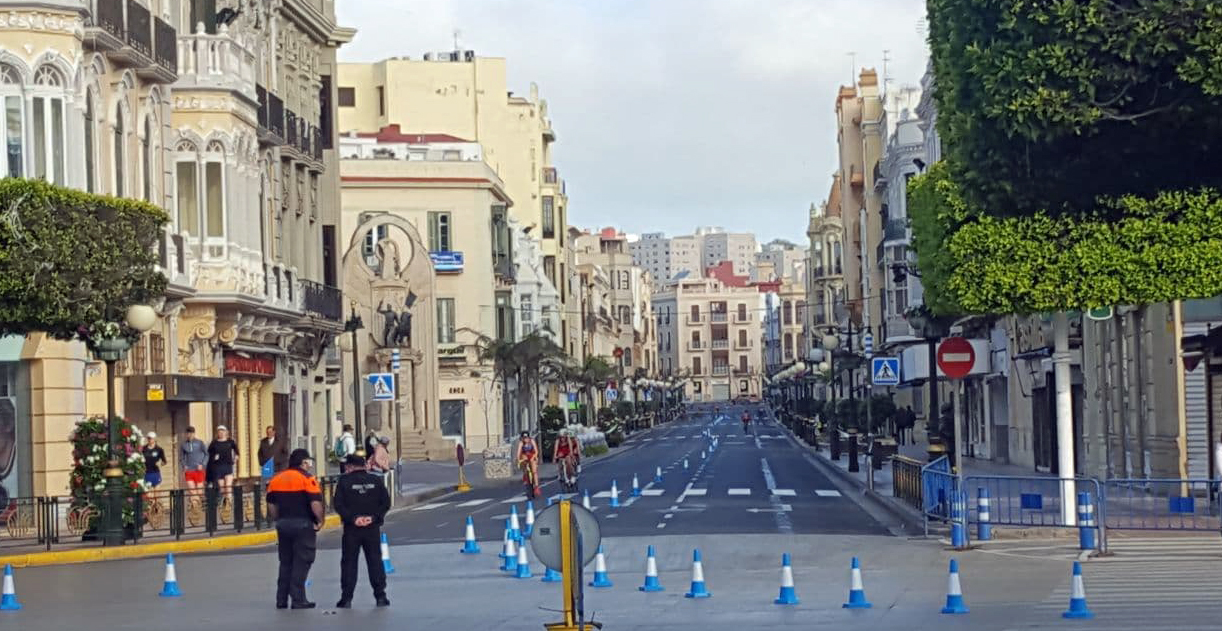
Out onto the newly-designed bike course, the athletes were taken deep in to the city along closed roads. For Melilla, triathlon has become a really important sport and this year the mass-participation events that ran alongside the main ETU feature were filled. It was show-time and the two athletes, in a commanding lead, had the roads to themselves.
The afternoon wind was making some sections quite a challenge and between the high buildings there were some sections where it was like a wind tunnel.
Carvalho and Pérez worked well together but behind them a group of 13 athletes were doing their best to catch up. An initial lead of 90 seconds began to grow as the Spanish-Portuguese team did their best to create as much distance as possible between them and the opposition.
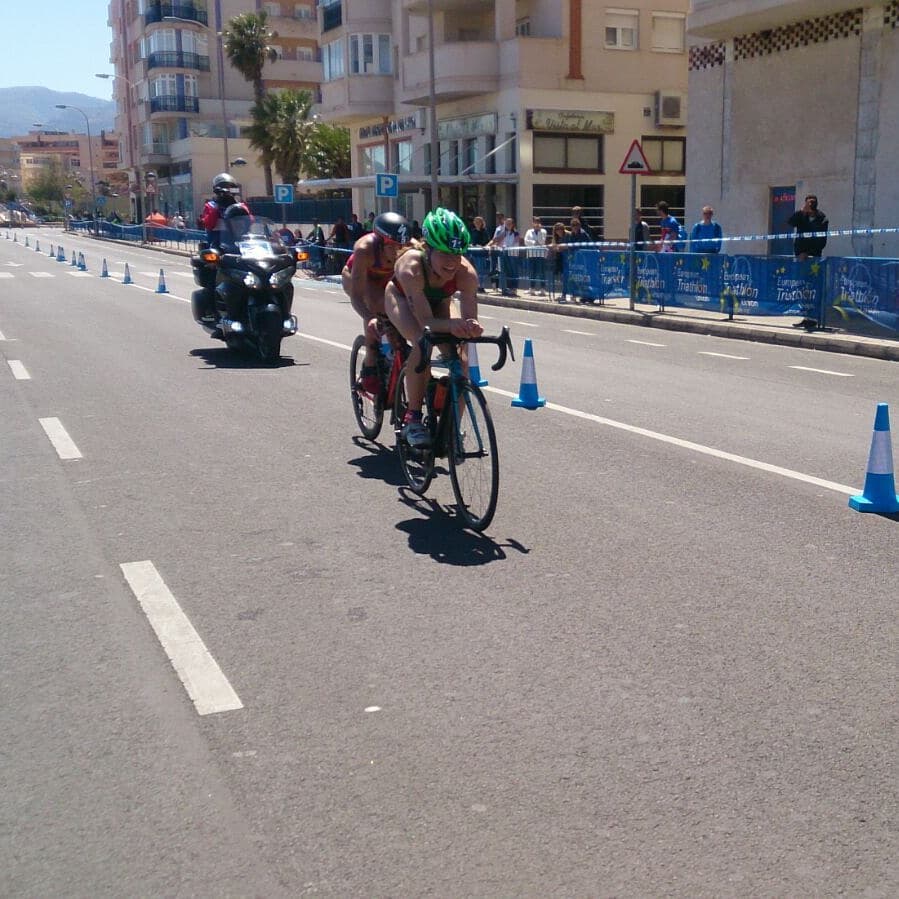
As the laps clicked down and as the lead built to 2:05, it looked like this was going to be a walk in the park for the two leaders but then fate, always potentially a cruel passenger, kicked in and Pérez, now with a slow puncture and no spare wheel at the wheel station. She stopped momentarily to try and resolve the problem herself but with no spare wheel, was forced to continue, riding on the rim. That was enough for Carvalho who broke way and sped off into the distance.
Suddenly Pérez was 40 seconds back and the bike was simply not responding.

The chase group, like a hunting pack, saw the problem and suddenly their pace kicked up a gear and the gap was now only 1:50.
Carvalho came into T2 alone and in a flash, had racked her bike, stowed her helmet and with her shoes fastened was out onto the run. The crowds had to wait but not so long, as Pérez, just under a minute behind, came in and had a great T2. She ran better off the bike and it looked pretty likely that she could catch the Portuguese athlete who, following her early strides on the run where she looked stiff and uncomfortable, was now striding out.
The chase group came in about 40 seconds behind Pérez and in that group were all the runners. Included in that group was Poland’s Maria Czesnik. We had to look twice at the race data but yes, born in 1977, she was here, in a great place in that group and running strong.
At the front of the race was Carvalho. She looked relaxed now but it was going to be a tough day out there with the multiple turns that gives any opposition a chance to see you, to spot you and to calculate the work they need to do to catch you. Pérez had her in her sights and it could only be a matter of time before the leader was caught.

The lead of 40 seconds began to crumble and along with Pérez there was Steinhauser, Camila Alonso Aradas ESP and Switzerland’s Lisa Berger. They were running relaxed and fast and with each dead turn they were able to calculate just how far ahead the leader was but more critically, they could see how she was running.
Each lap took the athletes back into the main square and the wall of sound created by the DJ. Running down towards the finish line, to a dead turn adjacent to the finish and then back for another lap. It was getting hot there and Carvalho did her best to keep ahead.
Her best was not enough to keep the attack of Alonso, who was running so well. Her strides along the road were as impressive as the swim strokes of Pérez and it was amazing to watch the way that she simply ate up the road. She attacked after the far eastern turn point and, midway along the promenade, she stormed past the leader, destroying the lead that had bene held by the Portuguese athlete for so long and continuing to build the pace, pulling away with every stride.
Looking so relaxed even at this stage of the race Alonso ran easily ahead of the chasing groups of Czesnik, Steinhauser, Carvalho, Berger and Pérez, who were some 40 seconds back now.
And then it was only Steinhauser and Berger who were in contention. Together they worked hard and were able to reduce the lead to about 20 seconds but with the bell sounding and only one short lap to go, Alonso continued, running relaxed and aware of the threat behind her.
Coming in to the square for the final time, the biggest smile you could possibly imagine, she had done enough to secure the title. Steinhauser had enough to kick before the carpet and break away from Berger and it was Czesnik, from Poland who claimed a mightily impressive 4th place ahead of Pérez, who really should have been on the podium. Her bike will need a really good check from the mechanic to ensure that her next race is one that gives her the right result.

After the race, Alonso shared her philosophy with us, “Que los obstáculos en el camino sólo te sirvan para hacerte más fuerte! May challenges make us stronger!”

The Junior Women raced earlier, starting the international day of races.
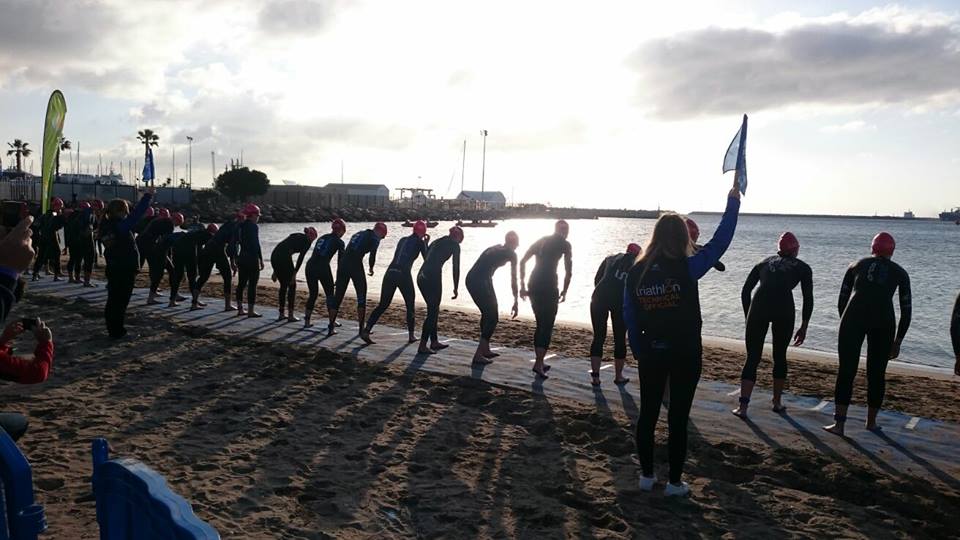
Earlier in the day, it had been the junior women that started the whole race festival.

The 750m swim was led by Claudia Perez Pay ESP in her second international race. We saw her swim pace in Gran Canaria when she exited the water with Jodie Stimpson. She was just a few seconds ahead of fellow Spaniard, Iria Rodríguez who led Israel’s Raz Poradosu. They were all comfortably ahead of the danger that we know Beatrice Mallozzi ITA to be but it was still a long way to go.
Mallozzi sped through T1 and suddenly, the highest-ranked athlete, Quinty Schoens was faced with a massive task. Her swim was over a minute down on the leader.

Poradosu and Rodríguez were well-placed with Mallozzi, whose bike power was simply unbeatable. Behind them, Italy’s Carlotta Missaglia remained a real threat on the run but the Italian, Israeli and Spanish trio had done just enough to keep the podium to themselves. Missaglia’s stunning 16:19 for the final 5k was not enough to bring her to the medals but showed everyone once more that she is a real threat on the run.

It was Mallozzi, as we expected, whose run power took her from a 2017 silver to a 2018 gold, with Rodríguez just having enough running to beat Poradosu to the silver.
Please click here for the results for the Junior Women
The finale for the day in Melilla was the Elite men’s race.
With 70 athletes lining up on the beach, they had earlier been able to see the race conditions as the Elite Women raced. Choosing the best place on the beach would be an important matter for the stronger swimmers who would want to break away and then form a small pack on the bike. The women did it. It worked. Would the men choose to do this as well?
The sun shone bright. The breeze appeared to have dropped and the sea was flat.

With a massive “On your marks!” the race was off. With the tide slightly low, the men, just as the women, had to dolphin their way into deeper water. This disruption gave an advantage to one athlete who was able to break away but the chase pack kept him in their sights and were soon on his toes.

Over the radios we could hear from the Technical Delegate that the start was clean; so no penalties so far.
Rounding the buoy and it became quite physical as the athletes bunched together. The beach now in front of them, the athletes were led by Mr Funky Trunks himself, Márk Dévay with Ireland’s Christopher Mintern comfortably on his toes. No turn on the beach, just like the women and they headed back out to sea for the final 750m lap.
Antonio Serrat Seoane came out of the water behind Dévay and Mintern but dropped as the leaders pushed hard on the initial stages of the bike. Mintern led, Dévay was with him along with Marco van der Stel and GB’s Jack Willis. Serrat soon caught them along with Tom Richard FRA and so it was six leading the race.

Richard, 2017 French national duathlon champion, can run off the bike and along with Serrat this could mean an explosive finish to the race.
As the pace increased, Mintern slid backwards and out of the safety of the leading peloton and as the leaders turned on the main square they had built a lead of 25 seconds.
The pack worked well together and the lead changed regularly to ensure the pace was fast. Could these leading 5 athletes hold off the charge of the pack?
In just one lap the leaders had worked enough to build that lead to over 30 seconds as news came back that race favourite and hugely popular Uxío Abuín Ares once again had suffered technical problems and was struggling in the main pack.
Back to the leaders and orders were being barked out to take the lead and to keep the speed high. With the many opportunities to see their challenger, the leaders were able to check and control their advantage and to continue to build.

The lead increased. The wind dropped. The bikes were going faster.
Spectators were lining the streets and cheering on the athletes. It is clear that the hard work of the local organisers and the continued support of the municipal authorities has made triathlon a “must-watch” sport and with the many opportunities that are now on offer to run, bike, run, or to swim, bike, run and to swim, run, the population in Melilla has embraced the sport.

Almost a minute was now the advantage with half the bike course completed. The chase pack had to start working.
A small breakaway from the main pack was trying to find their way closer to the leaders but this would be tough and a risky move.
At the front, the pace was so strong that they were now in sight of the tail-end of the race and there was a strong chance that some athletes would be lapped and taken out of the race.
90 seconds was the lead. This would ensure that anyone wanting to run the final 10k from the chase pack would have to be in superb form to catch the leaders. Willis ran 34:35 in Gran Canaria last year. Dévay ran 33:22 here last year. Serrat ran 31:33 in Weihai, Richard ran 31:57 in Cozumel as a U23 athlete. Van der Stel’s 32:05 at the Gran Canaria race last years suggested that these last athletes, on paper at least, had a chance for a podium place.
The bell sounding for the final lap gave the athletes a clear indication of their lead over the chase pack. It would be tense out there. 5 athletes; three medals.
Into T2 and it was a lightning fast transition from Van de Stel who led them out. Serrat set his mark on the race and led them from the turn point near to the finish, with Dévay hanging off the back.

The Spaniard kicked and kicked hard, He established a commanding lead in the first couple of minutes of the race and for Richard, Willis, van der Stel and Dévay, they could only watch in amazement.
The chase pack came in 80 seconds down and would have seen the leaders setting off. No doubt they would do their very best to hunt down the weaker ones and try for a podium place.
At the first turn, Serrat had over ten seconds on Richard and van der Stel. They kept their position; Serrat in sight, ahead of the others for the first lap as Serrat, all alone at the front, worked hard and seemed to fly over the roads.
The Richard and van der Stel combo was working well and at the far eastern turn of the course they had clearly made up ground. Serrat’s lead was now under serious threat. At the far western turn, he glanced over the road at the chasing duo and it looked, just for a second, as if his body had told him to ease up.
Cries of ¡Vamos! Rang out along the course for Serrat who was somehow holding off the French-Dutch challenge but these two athletes, watching his every step, were perfectly poised to attack and it was Richard who took the initiative. Serrat began to limp as they passed him. Possibly having gone to fast, too soon but Richard looked relaxed and was running easy.
At that western turn, Serrat had dropped 6 seconds. Gold looked lost.
The technical officials got the bell ready. Last lap.
Serrat was now 50m adrift and could see the athletes lining up behind him on the main square turn, all waiting to take his bronze medal position.

Neck and neck, pace for pace, Richard and van der Stel ran the seafront for the last time towards the western turn point. Lapping athletes as they went and using the turn to see just how far ahead of Serrat they were.
Richard was leading and the Dutchman, just sitting on his shoulder, was well-placed for a kick to take the lead. Serrat, still holding onto bronze was staying some 12 seconds back. The square was a massive ball of sound as the commentator and the DJ rocked and rolled. The crowds had gathered and it was on the blue carpet that the Dutchman just edged ahead of Richard.
A fantastic sprint finish for the crowds and Serrat came home for bronze.

The Junior Men, earlier in the day, provided a much tighter race but also revealed some gaps in training as there were many penalties for simple errors (discarding equipment and dismount). Valuable seconds were lost but these early season errors are easy to remedy and hopefully, the rest of the season will see fewer mistakes. The Technical Officials, using video cameras and keeping a close control over transition, ensured that no advantage was gained by athletes.
The swim was led by Ander Noain Lacamara. He has worked hard over the winter months and to the delight of the local crowds, it was he who led a long line of athletes up the beach and into T1. Not so far behind, but knowing he had strength in the bike and on the run, came Carlos Oliver Vives.
No breakaway amongst the junior men, so a tight group of athletes gave a great show for the spectators.
Each lap taking the pack to the main square, it was a great opportunity to see the athletes.
Powerful biking from Israel’s Yoav Avigdor along with Oliver and with help from Belgium’s Tom Van Cappellen ensured that the pace remained high but with Spain’s Romaric Forques in the mix and his proven pace on the run, it was a delighted home crowd who cheered him across the finish line.

Gold to Spain!

Forques 14:16 5k run took him to a convincing victory ahead of Avigdor, with Oliver rounding off the podium.

For a full set of results for the Junior Men, please click here
For the Israeli team, this was a good weekend. Two medals for the juniors gave their President, Michael Ziv, reason to celebrate, “We are very proud of our Juniors; 3rd place for the Junior Women and 2nd place for the Junior Men. With top ten places for another junior man and junior women, this is a good sign for our athletes and we believe we will do better as we proceed through the season.”

Spain can celebrate, with a gold, silver and bronze medal and Italy, with such strength in the junior women, can really look forward to an exciting season of races.
The National Rankings for the Juniors now looks like this
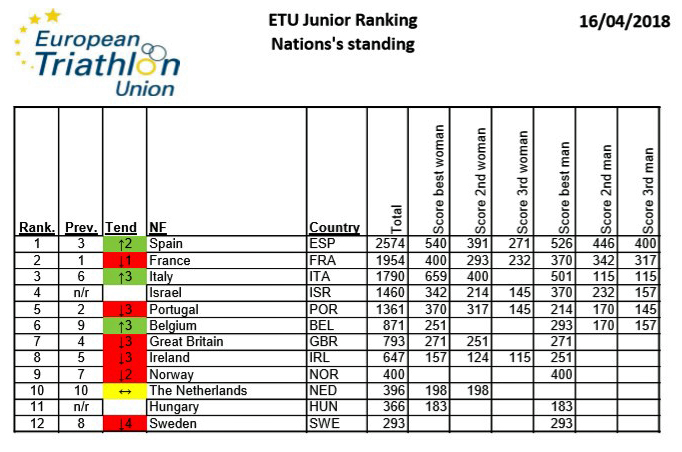
The U23 rankings have had a change around too


You can check out the Elite Rankings here
For those who want to watch the races again:
Please click here for the Elite Women
Please click here for the Elite Men
Big thanks to Ángel Fernández González, Spain’s “Voice of Triathlon” for his invaluable help and for sharing all his pictures with us, to Mechemelilla for the video of the sprint finish and of course to LaLiga4sports.es for the video coverage of the elite events.
Related Event: 2018 Melilla ETU Triathlon European Cup
| Results: Elite Men | |||
|---|---|---|---|
| 1. | Marco Van Der Stel | NED | 01:42:41 |
| 2. | Tom Richard | FRA | 01:42:43 |
| 3. | Antonio Serrat Seoane | ESP | 01:42:59 |
| 4. | Roberto Sanchez Mantecon | ESP | 01:43:43 |
| 5. | Samuel Dickinson | GBR | 01:43:44 |
| 6. | Barclay Izzard | GBR | 01:43:51 |
| 7. | Alexander Bryukhankov | RUS | 01:43:55 |
| 8. | Márk Dévay | HUN | 01:44:01 |
| 9. | Miguel Arraiolos | POR | 01:44:12 |
| 10. | Nathan Grayel | FRA | 01:44:17 |
| Results: Elite Women | |||
|---|---|---|---|
| 1. | Camila Alonso Aradas | ESP | 01:55:47 |
| 2. | Verena Steinhauser | ITA | 01:56:07 |
| 3. | Lisa Berger | SUI | 01:56:13 |
| 4. | Maria Czesnik | POL | 01:56:50 |
| 5. | Sara Perez Sala | ESP | 01:57:04 |
| 6. | Noémi Sárszegi | HUN | 01:57:12 |
| 7. | Marta Sanchez Hernandez | ESP | 01:57:28 |
| 8. | Melina Alonso Aradas | ESP | 01:58:00 |
| 9. | Valentina Riasova | RUS | 01:58:06 |
| 10. | Cecilia Santamaria Surroca | ESP | 01:58:10 |

